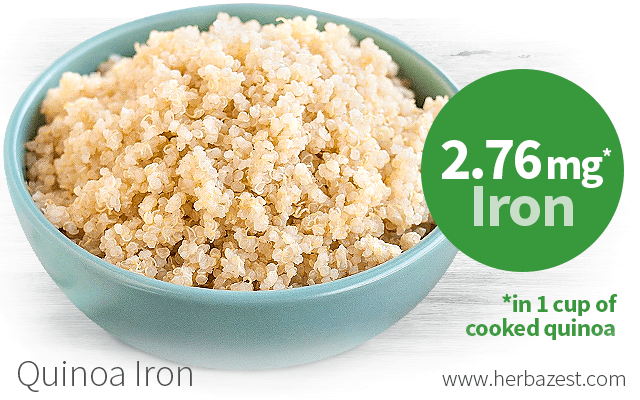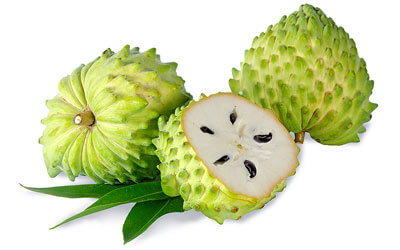Quinoa is known for being rich in nutrients, most notably all nine essential amino acids. However, this famous pseudograin is also an excellent source of vitamins and minerals, including iron.
What Is Iron?
Iron is a very important mineral that helps red blood cells carry and distribute oxygen to all parts of the body. It is also necessary for producing adenosine triphosphate, one of the body's major energy sources. When consumed in excess, iron is typically stored in the liver, bone marrow, spleen, and muscles.
The recommended daily iron intake for a healthy, non-vegetarian adult male between 19 and 50 years old is eight milligrams, while the daily recommended intake amount for a premenopausal female of the same age is 18 milligrams.1
Iron deficiency is actually very common, with approximately 80% of the world population experiencing deficiency of this mineral to different degrees. However, only approximately 30% of iron-deficient people can be considered to have anemia.
Less common is having elevated levels of iron in the body. This condition is called hemochromatosis and can contribute to liver damage, skin discoloration, and diabetes. Unlike some nutrients, iron is not excreted from the body, but rather stored away. For that reason, you should not take iron supplements without first consulting your doctor.
Iron in Quinoa
Quinoa is an excellent source of iron, containing approximately 2.76 milligrams per one cup (185g) of cooked quinoa.2
This is a very high level of iron compared to most grains, such as wheat, other vegetables, such as spinach, and even red meat, which is oftentimes considered the superior iron source. It should be noted that prolonged exposure to heat, such as cooking, will reduce the iron content of many foods.
However, despite the fact that quinoa is high in iron, a study published in The American Journal of Clinical Nutrition showed that this pseudo-cereal has a modestly lower iron absorption rate when compared to other cereals due its elevated content of phytate, which binds to minerals before they are properly digested, thus inhibiting their absorption.3
AS LITTLE AS 5-10 MG OF PHYTATE MAY INHIBIT IRON ABSORPTION BY 50%.
Another study published in the Journal of Science and Food Agriculture (2010) examined the effects of roasting and boiling on the diffusion of minerals, including iron in quinoa. The study found that boiling and roasting did not have a significant effect on the distribution of quinoa's minerals in the body.4
Moreover, the effects of processing on the solubility of quinoa's iron were also assessed in a study. While results demonstrated that iron solubility was not affected by cooking quinoa, it increased dramatically after soaking, germination, and fermentation.5
IN ORDER TO INCREASE IRON ABSORPTION, STUDIES SUPPORT THE CONSUMPTION OF SOAKED AND FERMENTED RAW QUINOA SEEDS.
Although it is clear that quinoa contains higher levels of iron than many other food sources, including true cereal grains, it has been observed that the rate of absorption of this mineral varies based on the way quinoa seeds are consumed. Although more research is needed to truly understand the behavior of iron in quinoa, this pseudograin makes for a great addition to a healthy diet thanks to its overall nutritional value.
Sources
- Journal of Nutrition and Food Sciences, Quinoa (Chenopodium quinoa Willd), from Nutritional Value to Potential Health Benefits: An Integrative Review, 2016
- Journal of Research in Medical Sciences, Review on iron and its importance for human health, 2014
- National Institutes of Health, Iron
- Scandinavian Journal of Gastroenterology, Wheat fiber, phytates and iron absorption, 1987
- FAOSTAT, International Year of Quinoa 2013, Nutritional Value
- USDA Nutrient Database, Quinoa, uncooked | Quinoa, cooked | Spinach, raw | Beef, chuck eye roast, boneless, America´s Beef Roast, separable lean only, trimmed to 0” fat, choice, raw | Wheat flour, whole-grain, soft wheat
- University of Maryland Medical Center, Iron
- Mayo Clinic, Iron deficiency anemia, Prevention
Footnotes:
- National Library of Medicine. (2001). Dietary Reference Intakes for Vitamin A, Vitamin K, Arsenic, Boron, Chromium, Copper, Iodine, Iron, Manganese, Molybdenum, Nickel, Silicon, Vanadium, and Zinc. Retrieved June 6, 2021 from https://www.ncbi.nlm.nih.gov/books/NBK222309/
- US Department of Agriculture. (2019). Quinoa, cooked. Retrieved June 6, 2021 from https://fdc.nal.usda.gov/fdc-app.html#/food-details/168917/nutrients
- The American Journal of Clinical Nutrition. (1997). The influence of different cereal grains on iron absorption from infant cereal foods. Retrieved June 6, 2021 from https://academic.oup.com/ajcn/article/65/4/964/4655549
- Journal of Science and Food Agriculture. (2010). Effects of roasting and boiling of quinoa, kiwicha and kañiwa on composition and availability of minerals in vitro. Retrieved June 6, 2021 from https://onlinelibrary.wiley.com/doi/abs/10.1002/jsfa.4053
- International Journal of Food Sciences and Nutrition. (1999). Processing of quinoa (Chenopodium quinoa, Willd): Effects on in vitro iron availability and phytate hydrolysis. Retrieved June 6, 2021 from https://www.researchgate.net/publication/12686180_Processing_of_quinoa_Chenopodium_quinoa_Willd_Effects_on_in_vitro_iron_availability_and_phytate_hydrolysis




